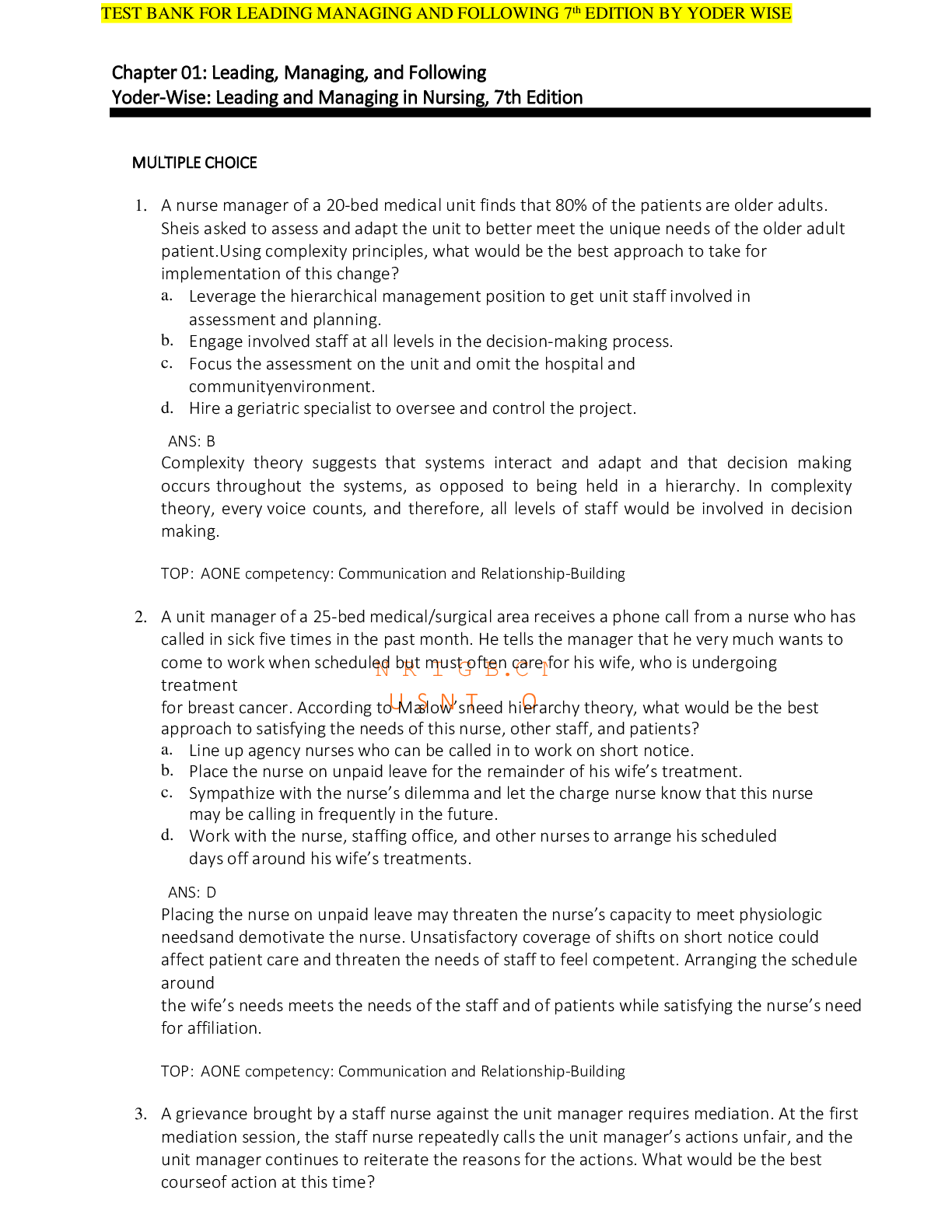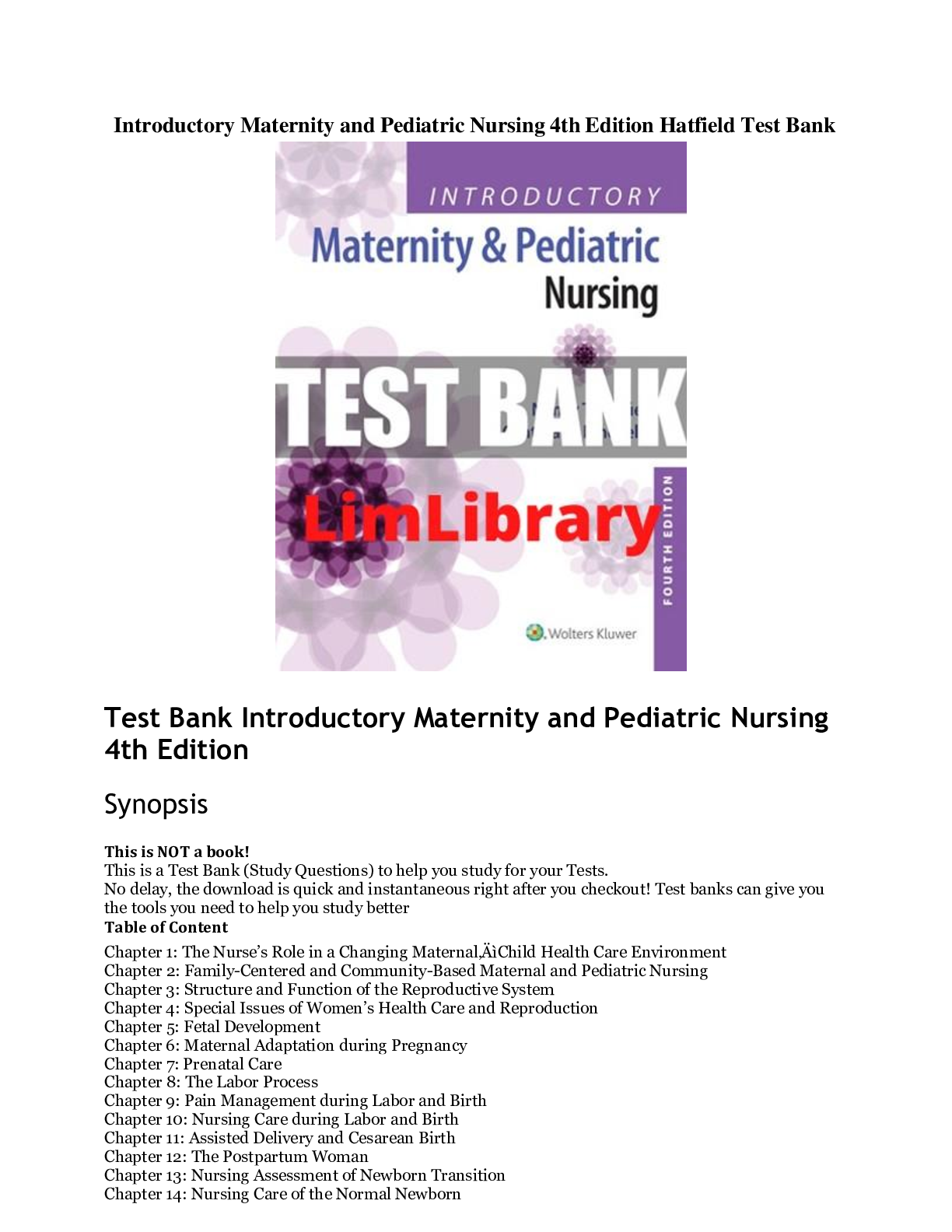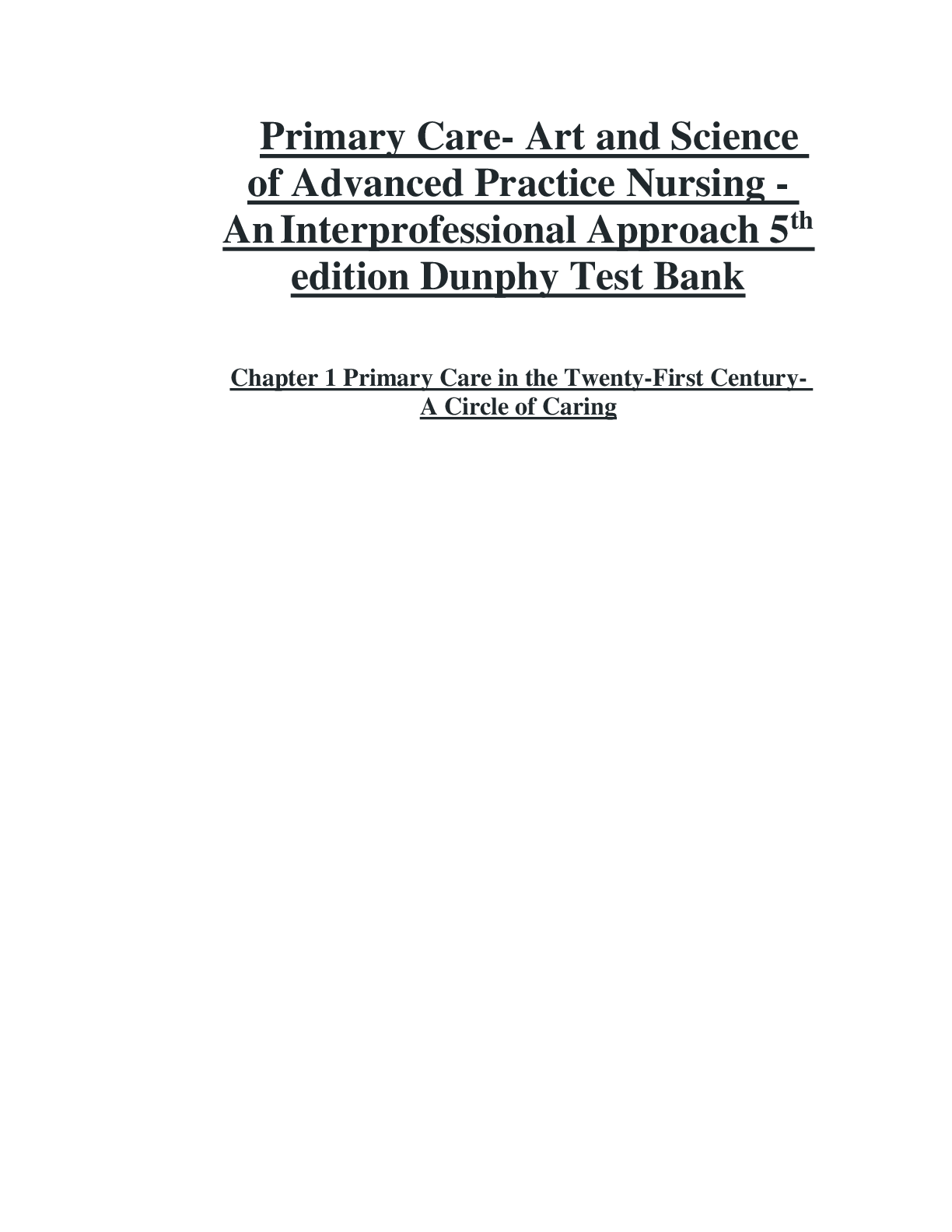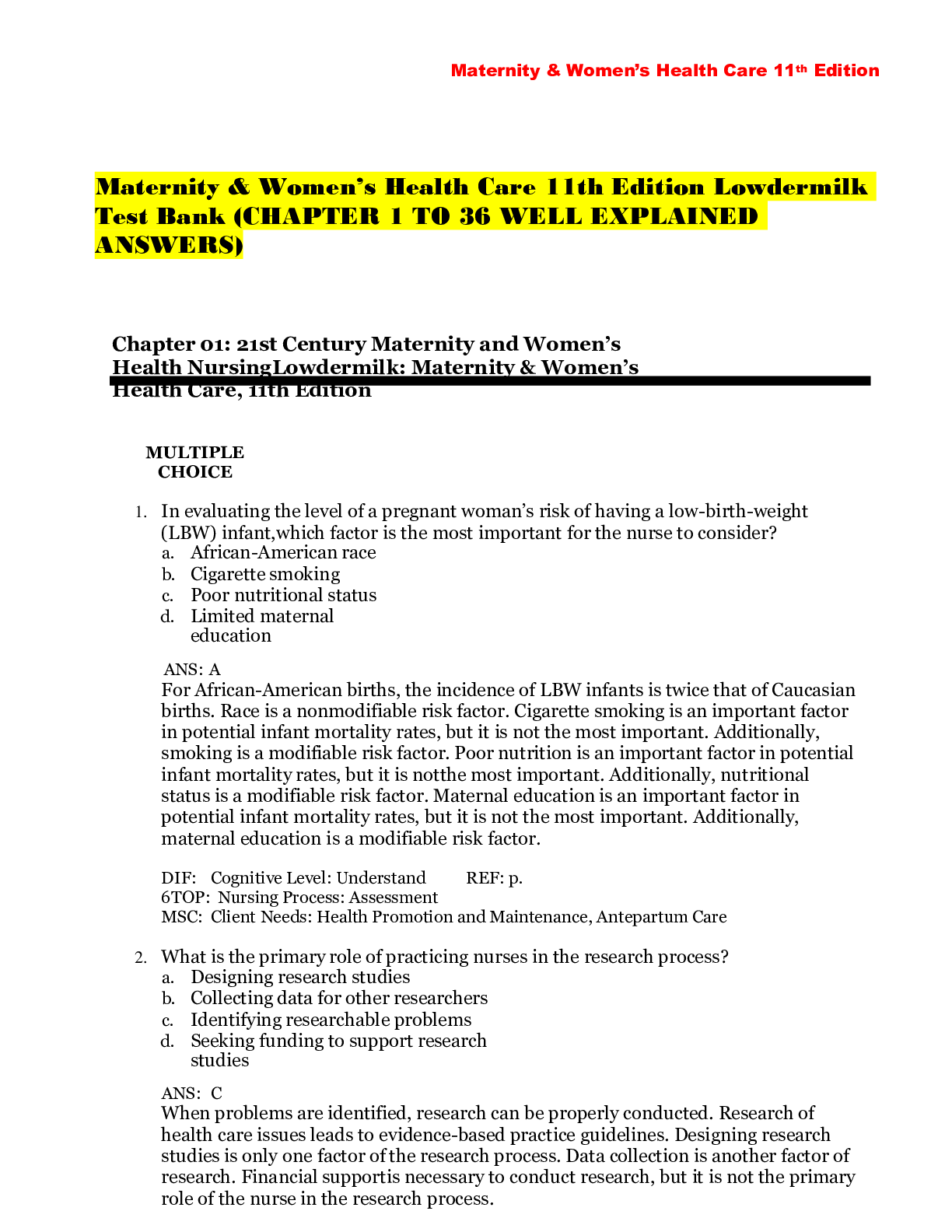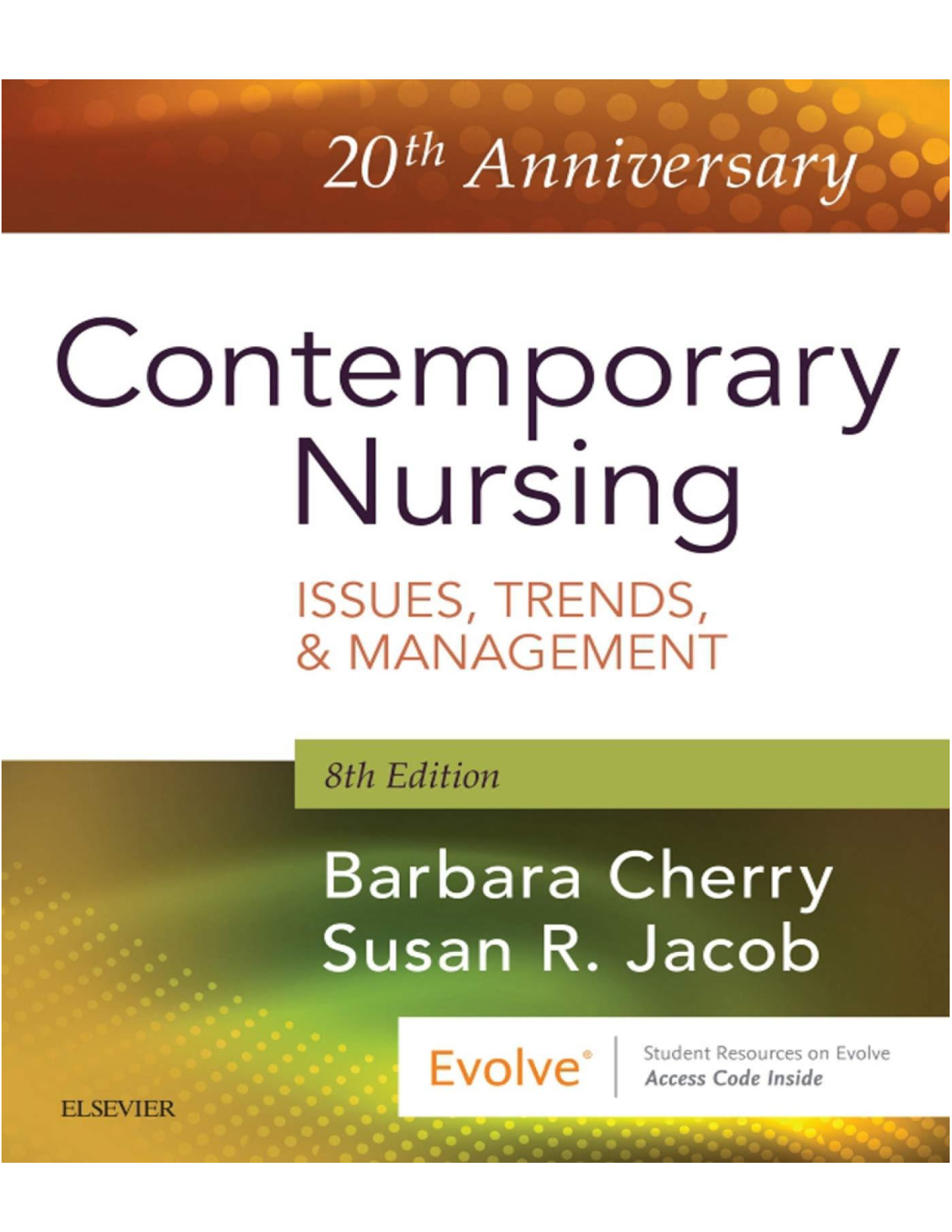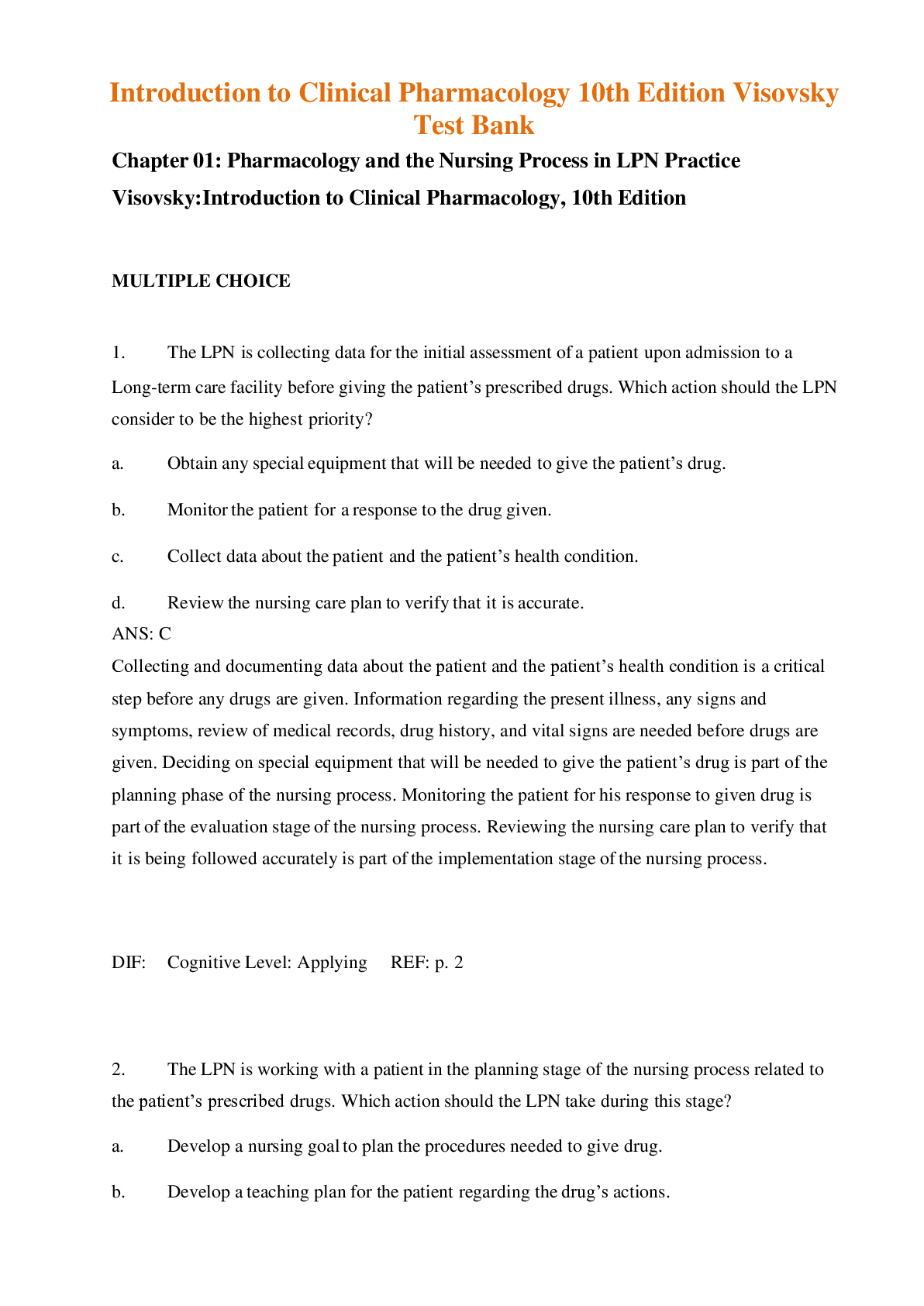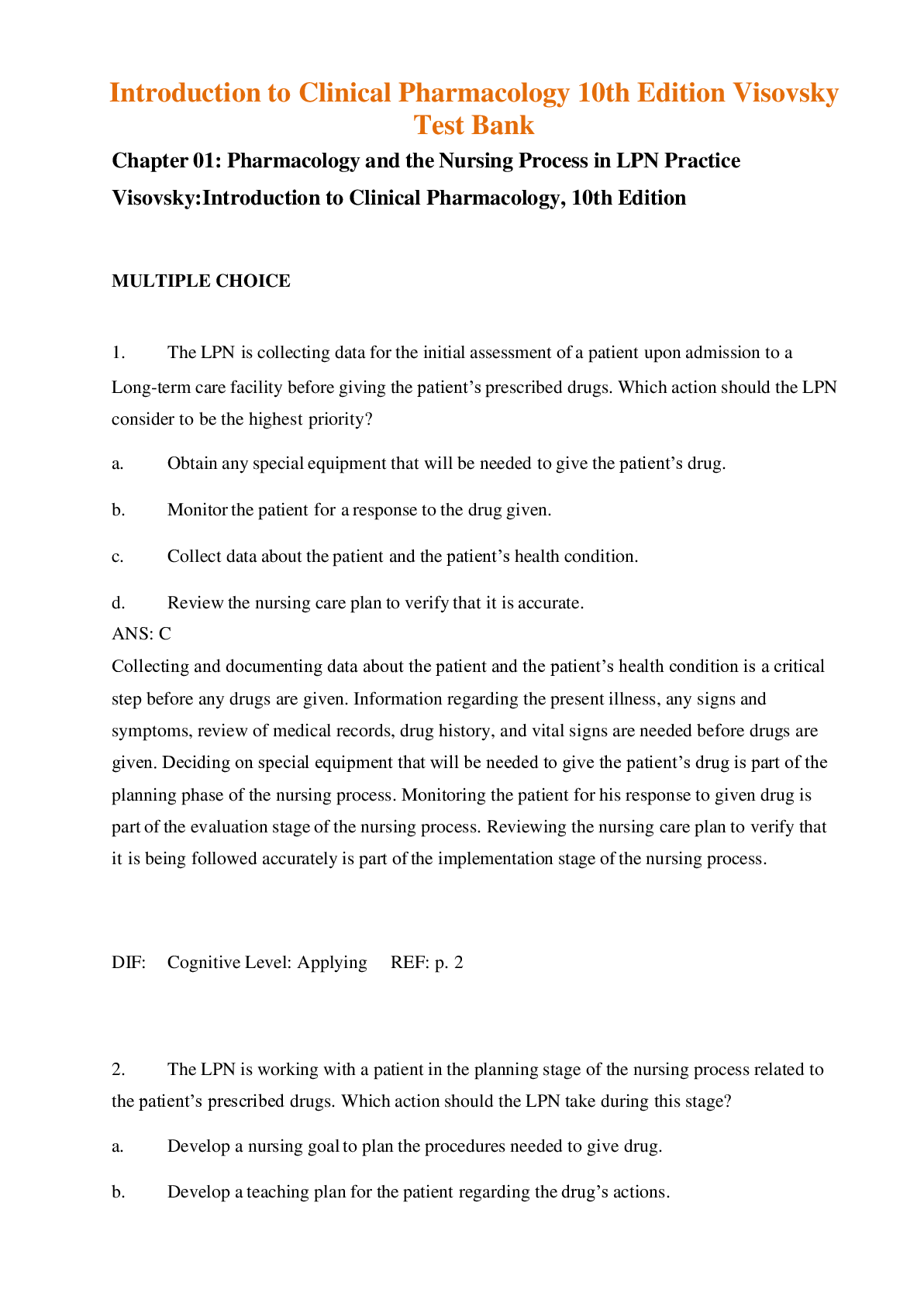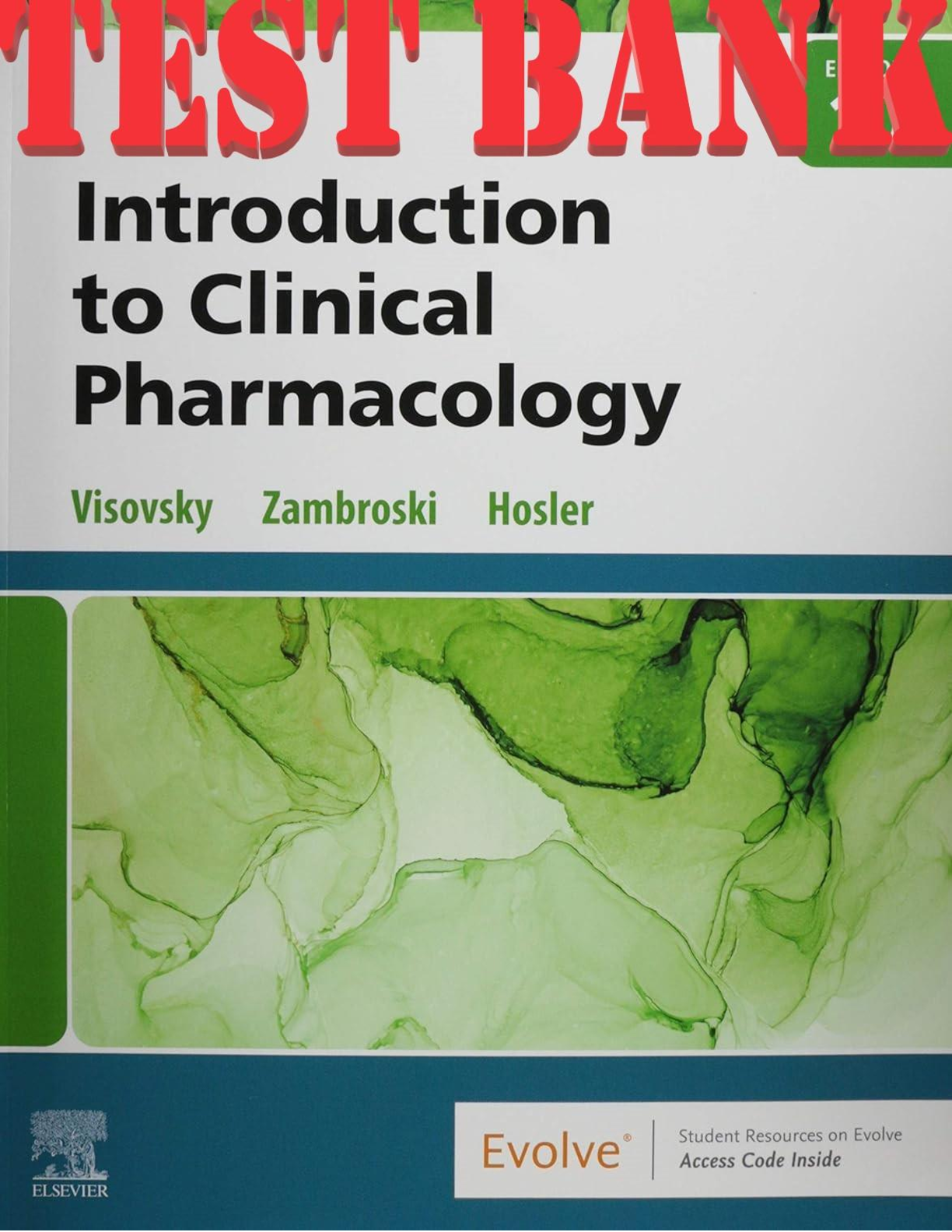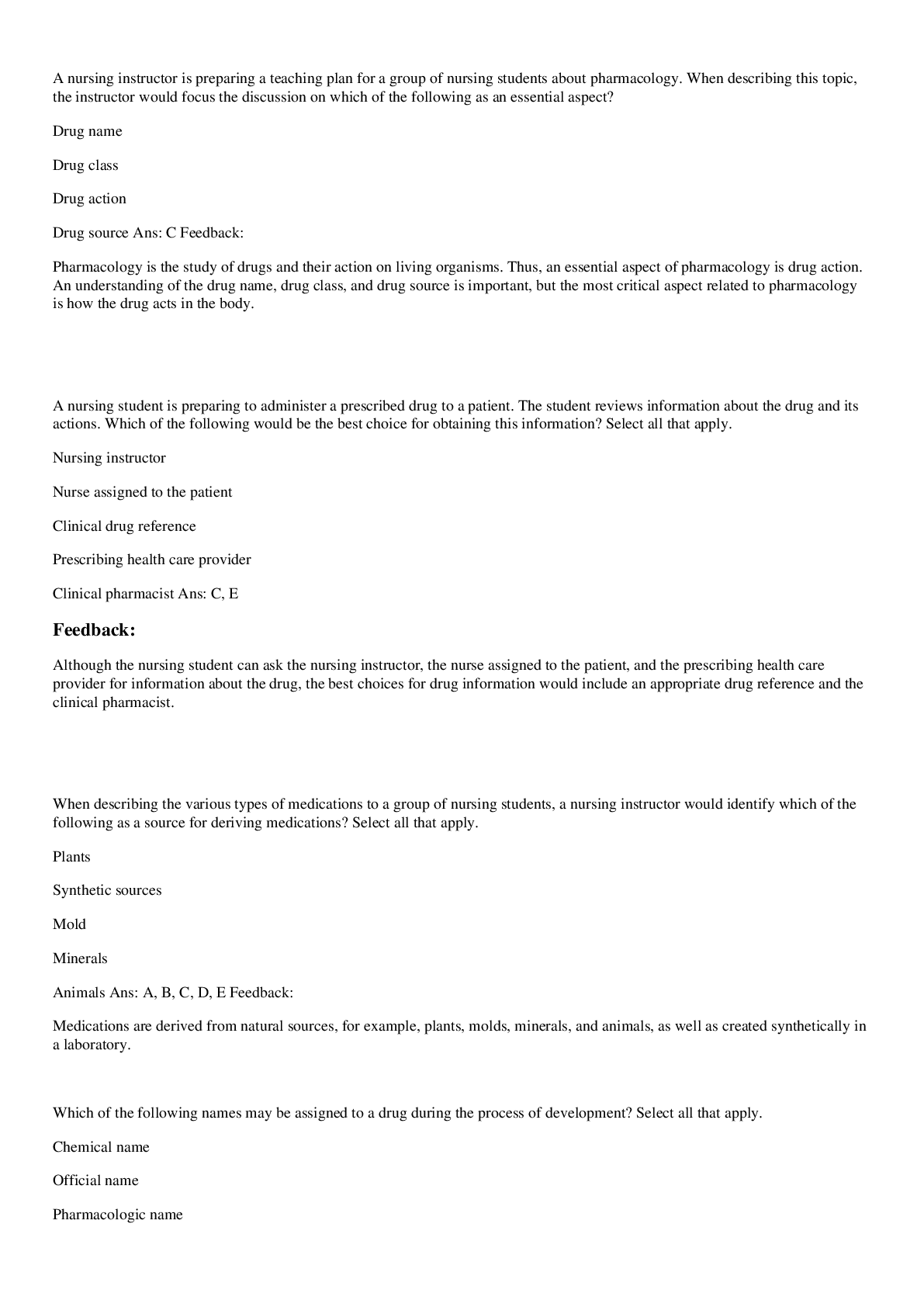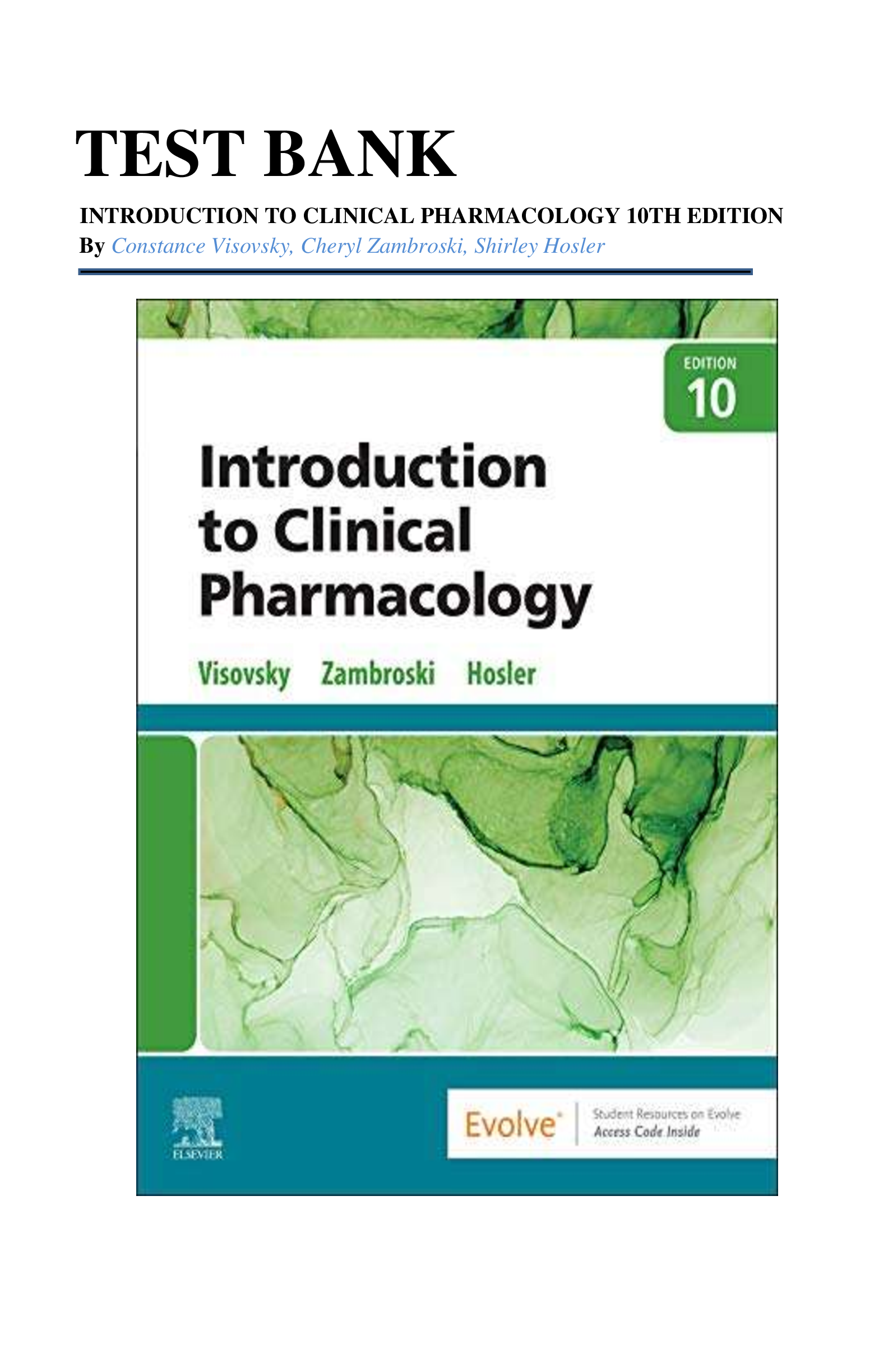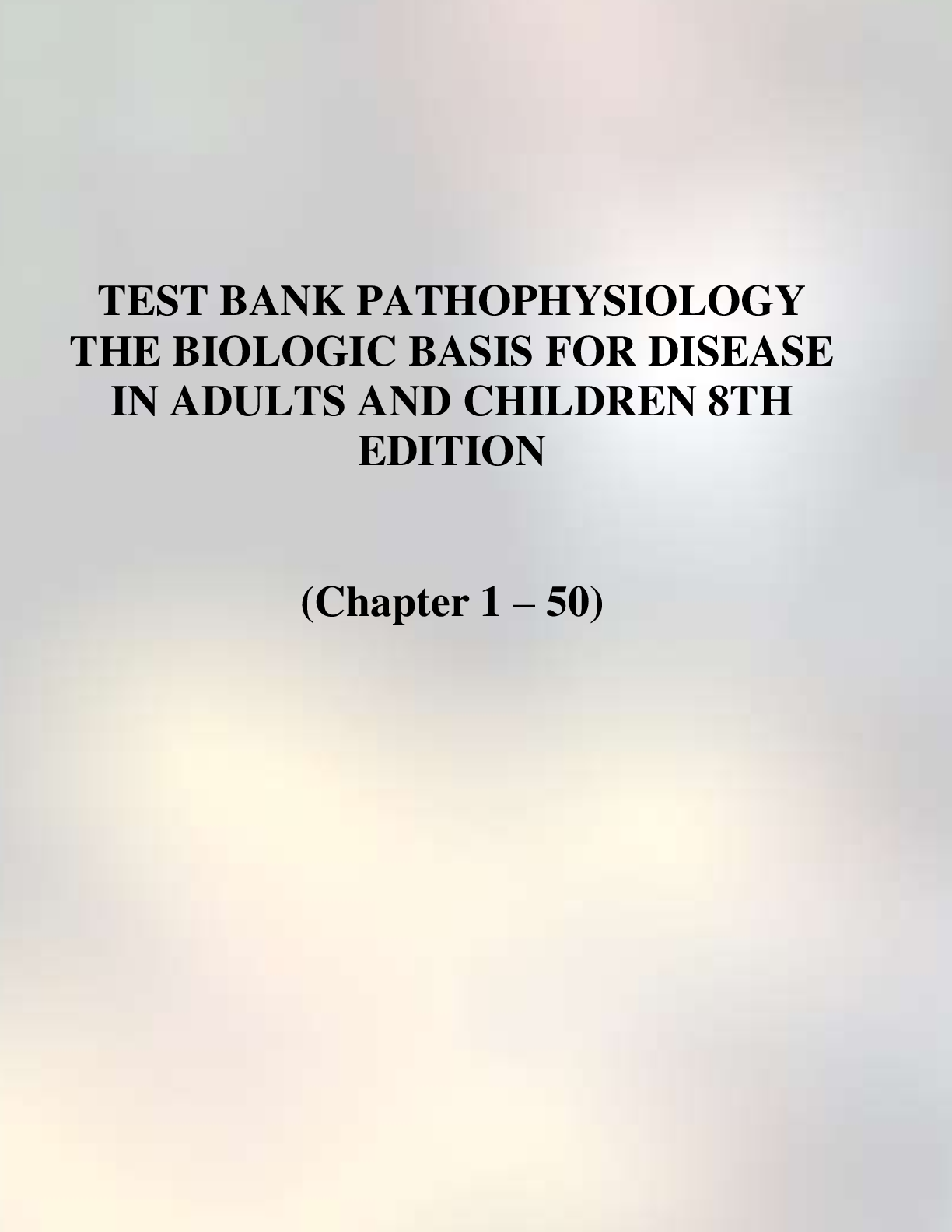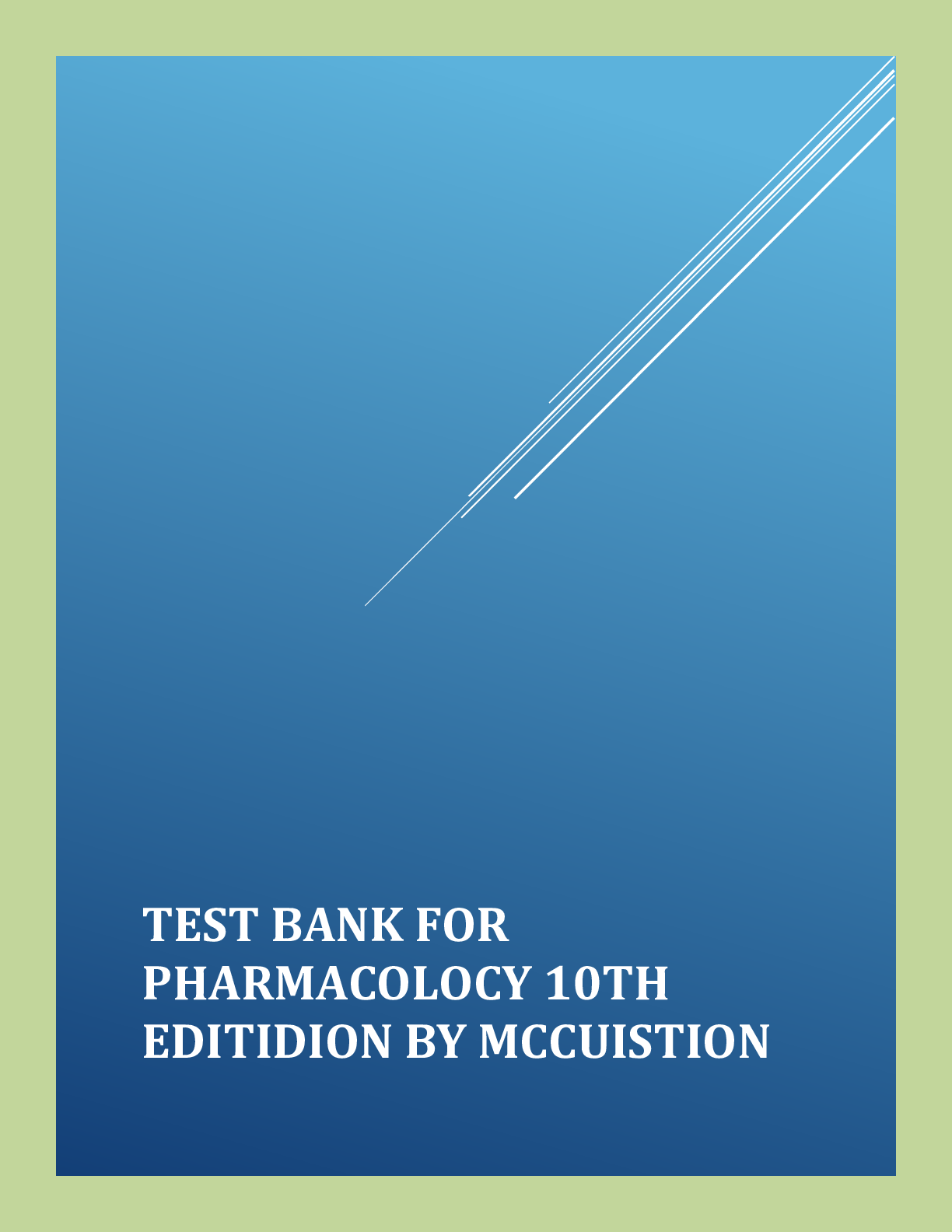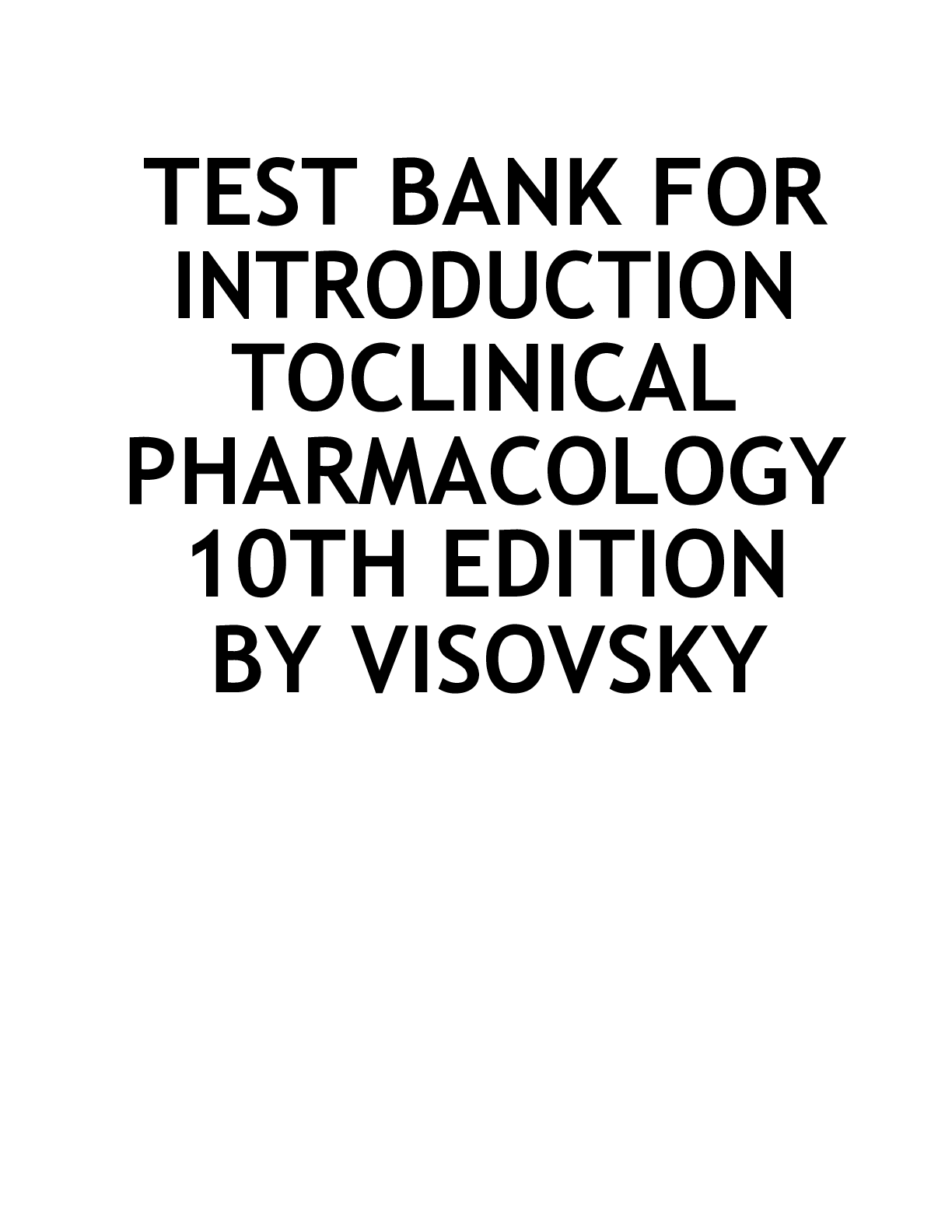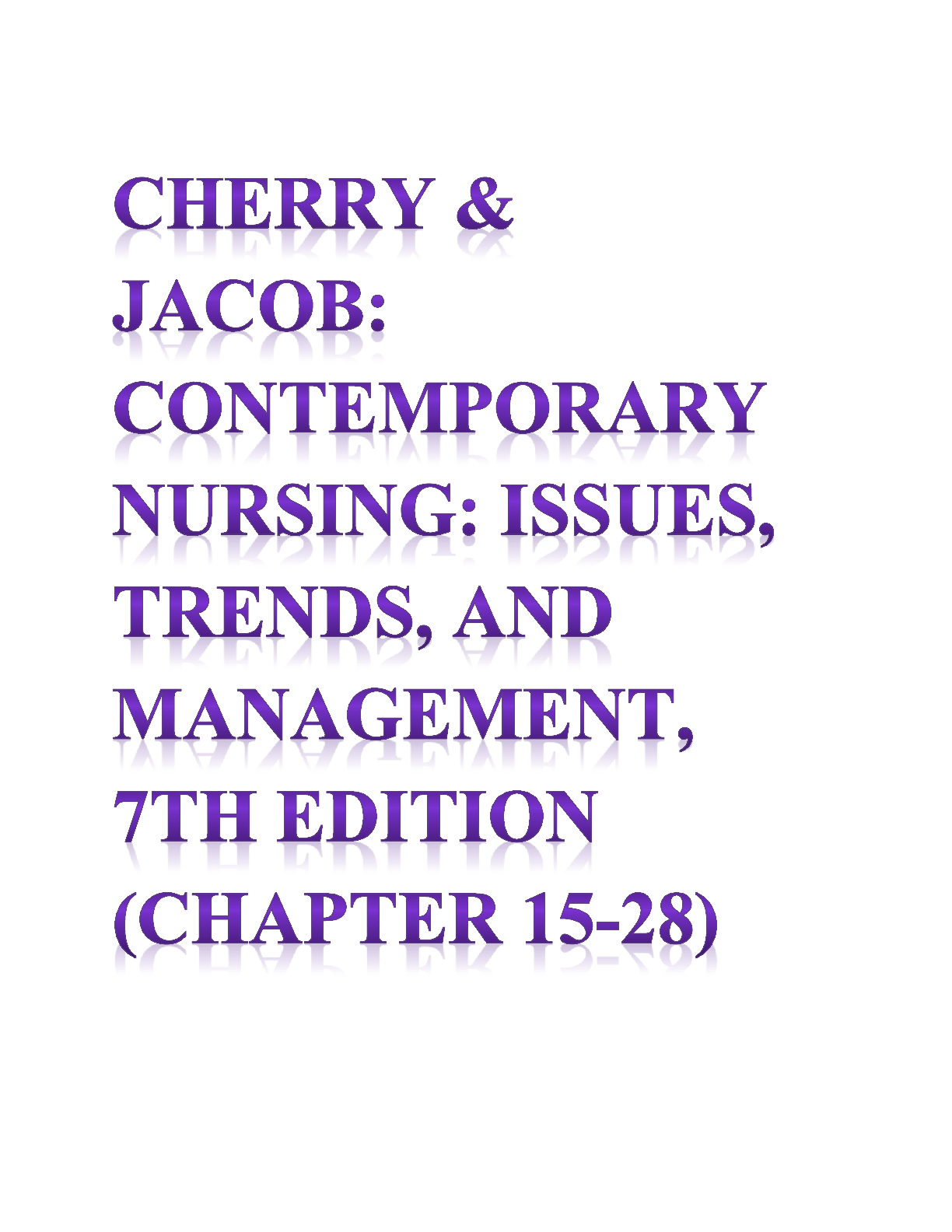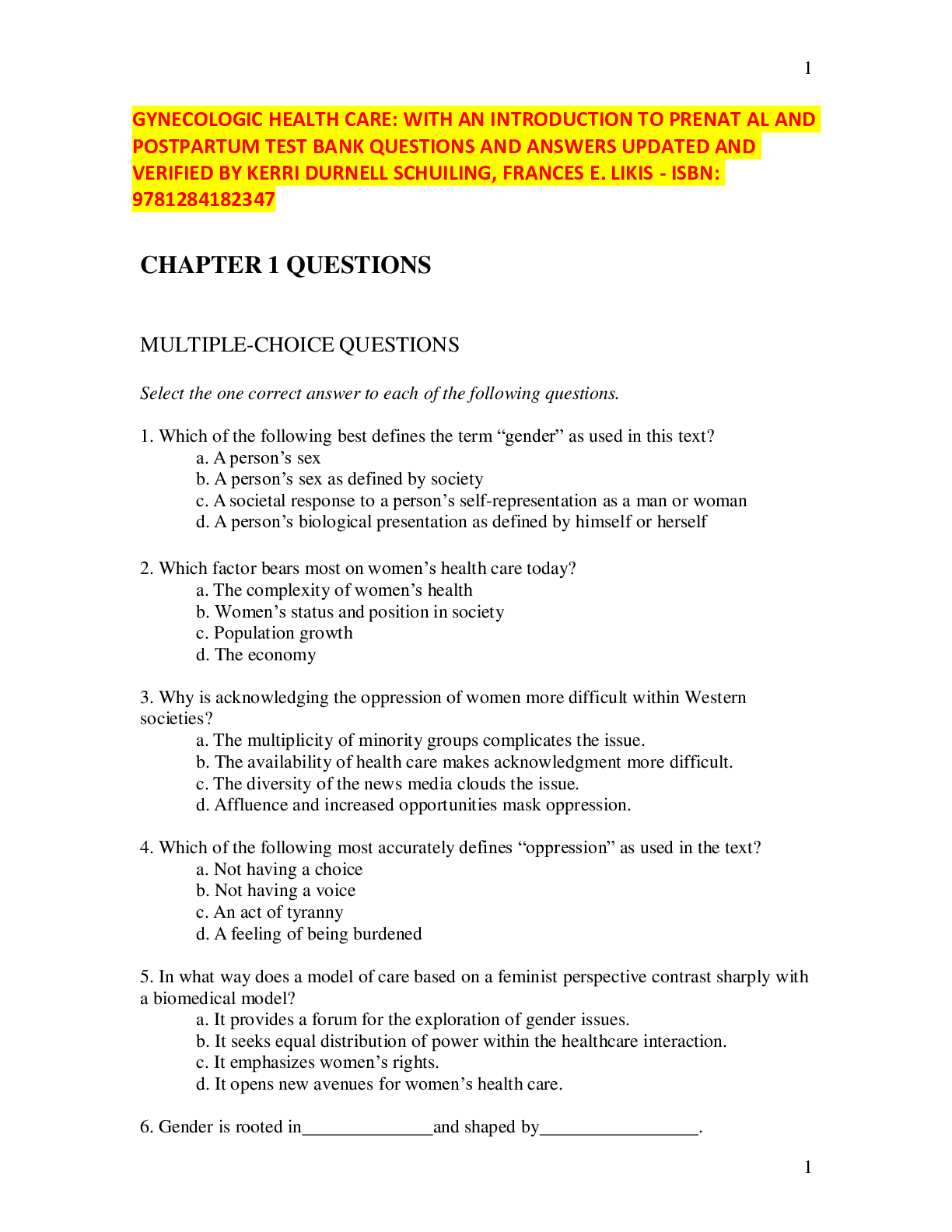*NURSING > TEST BANK > TEST BANK FOR INRODUCTION TO CLINICAL PHARMACOLOGY 10TH EDITION (Chapter 1 - 20) BY VISOVSKY (All)
TEST BANK FOR INRODUCTION TO CLINICAL PHARMACOLOGY 10TH EDITION (Chapter 1 - 20) BY VISOVSKY
Document Content and Description Below
TEST BANK FOR INRODUCTION TO CLINICAL PHARMACOLOGY 10TH EDITION (Chapter 1 - 20) BY VISOVSKYChapter 01: Pharmacology and the Nursing Process in LPN Practice Visovsky: Introduction to Clinical Pharmaco... logy, 10th Edition MULTIPLE CHOICE 1. The LPN is collecting data for the initial assessment of a patient upon admission to a long-term care facility before giving the patient’s prescribed drugs. Which action should the LPN consider to be the highest priority? a. Obtain any special equipment that will be needed to give the patient’s drug. b. Monitor the patient for a response to the drug given. c. Collect data about the patient and the patient’s health condition. d. Review the nursing care plan to verify that it is accurate. ANS: C Collecting and documenting data about the patient and the patient’s health condition is a critical step before any drugs are given. Information regarding the present illness, any signs and symptoms, review of medical records, drug history, and vital signs are needed before drugs are given. Deciding on special equipment that will be needed to give the patient’s drug is part of the planning phase of the nursing process. Monitoring the patient for his response to given drug is part of the evaluation stage of the nursing process. Reviewing the nursing care plan to verify that it is being followed accurately is part of the implementation stage of the nursing process. DIF: Cognitive Level: Applying REF: p. 2 2. The LPN is working with a patient in the planning stage of the nursing process related to the patient’s prescribed drugs. Which action should the LPN take during this stage? a. Develop a nursing goal to plan the procedures needed to give drug. b. Develop a teaching plan for the patient regarding the drug’s actions. c. Determine that the patient is experiencing the expected response to his drug. d. Determine how much the patient understands about his drug. ANS: D Determining how much the patient understands about his drug is part of the diagnosis phase of the nursing process. Developing a nursing goal to plan the procedures needed to give drug and developing a teaching plan for the patient regarding the drug’s actions are part of the planning phase of the nursing process. DIF: Cognitive Level: Applying REF: p. 2 3. You are teaching a patient with depression about the potential adverse effects of a prescribed drug. What part of the nursing process related to drug therapy are you engaging in at this point of the teaching plan? a. Assessment b. Implementation c. Evaluation d. Diagnosis ANS: C In the evaluation phase of the nursing process, the LPN understands and teaches to the patient the drug’s therapeutic effects, expected side effects, and potential adverse effects. DIF: Cognitive Level: Remembering REF: p. 2 4. Which of the following is an example of subjective data? a. The patient states she has pain in her left arm. b. The medical chart has a recorded blood pressure of 128/88. c. The serum potassium level is 3.8 mmol/L. d. The patient’s ECG shows normal sinus rhythm. ANS: A Reports from the patient or patient’s caregiver are considered subjective data. Symptoms such as pain, nausea, or dizziness are examples of symptoms that cannot be “seen” and are data collected from the patient, caregiver, or others. Laboratory values, ECG results, or vital sign data from a medical chart are examples of objective data. DIF: Cognitive Level: Remembering REF: p. 2 5. Which statement provides an example of objective data? a. The wife states the patient was confused last night. b. Grimacing with movement is present during the examination. c. The patient reports moderate alcohol consumption. d. The patient states pain is severe. ANS: B Measurable data obtained during a physical exam such as grimacing with movement is an example of objective data. Subjective data includes information presented by the patient or family that cannot be substantiated such as a wife’s report of a patient’s confusion, patient report of degree of alcohol consumption, and a patient’s pain rating. DIF: Cognitive Level: Remembering REF: p. 3 6. The LPN/VN is assessing a patient before giving a drug for blood pressure management. The nurse notes the blood pressure to be 90/50 mm Hg. What is the nurse’s best action? a. Hold the drug and report the blood pressure to the RN. b. Give the patient a full glass of water before giving the drug. c. Come back in 30 minutes and recheck the blood pressure. d. Have the patient perform pursed lip breathing before giving the drug. ANS: A The best action is to hold the drug and contact the RN. The patient may need an adjustment to the dose of the blood pressure drug or switching to another drug. Giving water with the drug is not contraindicated but does not recognize the patient’s risk for hypotension. Pursed lip breathing has no role in this situation. DIF: Cognitive Level: Remembering REF: p. 4 7. The LPN is collecting objective data for inclusion in the nursing assessment. Which piece of information indicates that the LPN has a clear understanding of objective assessment data? a. A patient’s rating of chest pain as 8 on a 1 to 10 scale. b. Family members report that patient has been experiencing pain for 1 month. c. Detailed history of the patient’s current illness upon admission. d. Compilation of past laboratory results and x-ray reports. ANS: D The patient’s past laboratory and x-ray results are examples of objective data. A pain rating of 8/10, a family member’s description of the patient’s pain, and history of current illness are examples of subjective data. DIF: Cognitive Level: Remembering REF: p. 3 8. A patient recently began a taking blood pressure drug and presents for a follow-up appointment. The office nurse reviews the patient’s daily blood pressure recordings. Which stage of the nursing process corresponds to this review? a. Assessment b. Planning c. Diagnosis d. Evaluation ANS: D The evaluation phase involves examining the results that occur when the plan is implemented. Reviewing the patient’s daily blood pressure recording examines the patient’s response to the drug. The assessment phase provides initial information about the patient, the problem, and anything that may change the choice of treatment. The planning phase involves using patient assessment data and diagnoses to set goals and write care plans. The diagnosis phase involves decision-making about the patient’s problems, including medical diagnoses made by the healthcare provider and nursing diagnoses developed through the North American Nursing Diagnosis Association (NANDA). DIF: Cognitive Level: Remembering REF: p. 2 9. After receiving report, the LPN gives drugs to her assigned patients on the evening shift. With which stage of the nursing process does this activity correspond? a. Implementation b. Assessment c. Planning d. Diagnosis ANS: A The implementation phase involves actively following the plan of care and accurately giving ordered drug to the patients. The assessment phase involves obtaining initial information about the patient, the problem, and anything that may change the choice of treatment. The planning phase involves using patient assessment data and diagnoses to set goals and write care plans. The diagnosis phase involves decision-making about the patient’s problems, including medical diagnoses made by the healthcare provider and nursing diagnoses developed through the North American Nursing Diagnosis Association (NANDA). DIF: Cognitive Level: Remembering REF: p. 5 10. You are reviewing a patient’s new antihypertensive drug order. The order as written is unclear as to the number of times per day the drug is to be given. What is your best action? a. Call the healthcare provider to clarify the order. b. Refer the question to the hospital pharmacy. c. Give the drug according to the information in a drug handbook. d. Hold the drug until the healthcare provider returns the following day. ANS: A Your responsibility as a nurse giving drugs is to apply knowledge about the specific drug and drug orders. No part of the drug order should be unclear. Any questions related to the drug, dose or appropriateness for the specific patient should be answered before the drug is given. DIF: Cognitive Level: Understanding REF: p. 4 11. A patient is receiving an antibiotic for pneumonia. On the third day of the treatment regimen, a rash appears on her chest, and she reports itching and shortness of breath. Which term describes the effect that has occurred? a. Therapeutic effect b. Adverse effect c. Side effect d. Overdose effect ANS: B An itchy rash with shortness of breath that develops in response to drug is an example of an allergic reaction or adverse effect to the antibiotic. Therapeutic effects occur when an antibiotic fights infection without causing any adverse effects. Side effects of drugs are known potential effects of the antibiotic that range from mild to moderate. An overdose occurs if a patient receives too much of a drug. DIF: Cognitive Level: Understanding REF: p. 9 12. An LPN enters a patient’s room to give a scheduled drug. Before administration, the patient states, “I can’t take that drug; I’m allergic to it.” What should the nurse do first? a. Reassure the patient that the drug is needed and observations regarding possible allergic symptoms will be made. b. Review the patient record and encourage the patient to take the drug if no allergies have been documented. c. Assess the patient’s allergic history and notify the healthcare provider to determine a course of action. d. Document patient refusal and leave a note on the patient chart for the healthcare provider. ANS: C The patient has shared information that indicates the potential for the ordered drug to cause adverse effects. Before giving the drug, the nurse should investigate further by obtaining a more detailed drug history and notifying the healthcare provider who wrote the order. Although the order may be accurately written, determining whether the drug’s benefits outweigh the risks is not an action within the legal scope of the nurse’s practice. The nurse should not offer false reassurance and as an advocate for patient safety, should investigate further before giving the drug. The patient has raised concerns regarding the drug that should promptly be brought to the provider’s attention. A note on the chart leaves potential for information to be missed. DIF: Cognitive Level: Applying REF: p. 4 13. The LPN is preparing to give the initial dose of an antibiotic to a patient diagnosed with an infection. The patient says, “I broke out in a rash the last time I took that pill.” What action should the LPN take next? a. Give the drug and check the patient in 30 minutes for a rash. b. Document that the patient refused the drug per agency policy. c. Leave the drug at the bedside while checking the chart for the patient’s allergies. d. Notify the registered nurse or healthcare provider. ANS: D This is a possible adverse reaction, and the RN or healthcare provider should be notified immediately. You would never give the drug to see if it does cause a rash. Drug should never be left at the bedside. The patient did not refuse the drug. DIF: Cognitive Level: Applying REF: p. 9 14. Which priority assessment must you make before giving any patient a drug by mouth? a. Quiz the patient about the action of each drug. b. Make sure the patient can swallow. c. Find out whether the patient prefers cold or room temperature liquids. d. Ask the patient to repeat his or her name and birthdate. ANS: B Before the patient can take any drug by mouth, they must be able to swallow. Asking the patient to repeat his name and birthdate may be part of using two identifiers but this is important with all patients. Preferences are also important, but the priority is that the patient be able to swallow the drug. DIF: Cognitive Level: Understanding REF: p. 8 MULTIPLE RESPONSE 1. You are preparing to give the morning drugs to your assigned patients. Before giving each drug, which steps are considered to be “rights” of giving a drug? (Select all that apply.) a. The right plan b. The right time c. The right dose d. The right patient e. The right to self-administer f. The right drug ANS: B, C, D, F The nine rights associated with giving drugs are as follows: right patient, right drug, right time, right dose, right route, right documentation, right reason, right response, and right to refuse. DIF: Cognitive Level: Remembering REF: p. 5 2. A licensed practical/vocational nurse has a specific set of roles and responsibilities. Which responsibilities are within the scope of an LPN/LVN? (Select all that apply.) a. Writing medical orders b. Assessment of admission vitals to report to the admitting RN c. Conducting a comprehensive admission assessment d. Independent initiation of comprehensive plan of care e. Management of patient care under RN supervision ANS: B, E Assisting the RN in gathering specific data such as vital signs is within the scope of LPN/LVN practice. The LPN/LVN works directly with the patient and manages care and assists the RN in data collection and care plan development. The LPN/LVN does not have the legal authority to write medical orders or carry out the admission assessment. LPNs/LVNs are more dependent in the planning and evaluation phase of the nursing process. An LPN/LVN can collect data to assist the RN with care plan development but is unable to initiate a comprehensive plan of care independently. DIF: Cognitive Level: Remembering REF: p. 3 3. The LPN is collecting subjective data for inclusion in the nursing assessment. What information indicates that the LPN has a clear understanding of the nature of subjective assessment data? (Select all that apply.) a. Pulse rate b. ECG brought in by the patient c. Chief complaint of chest pain in the patient’s own words d. Auscultation of lung sounds e. The patient’s statement of current over the counter and prescription drugs f. The patient’s laboratory test results ANS: C, E Subjective data include information given by the patient or family, like concerns or symptoms felt by the patient, and their statement of mediations. The pulse rate, recent ECG, laboratory test results, and lung auscultation obtained through physical examination are examples of objective data. DIF: Cognitive Level: Remembering REF: p. 3 4. A 72 year-old female patient has just been admitted to a rehabilitation center for extended physical therapy following a stroke. You are obtaining the patient’s drug history. Which information should you collect? (Select all that apply.) a. Drugs currently being taken b. Over-the-counter drugs being taken c. Referrals to specialists d. Diseases or conditions requiring drugs e. Use of herbal supplements f. Past medical history g. Alcohol use h. Drug allergies ANS: A, B, D, E, G, H Important information to gather from a patient’s drug history are the current prescription drugs, OTC drugs, the conditions that denote the patient’s need for a drug, alcohol use, drug allergies, and the use of nutritional or herbal supplements. The remaining choices are items in the history of present or past illnesses, and not concerned with drugs. DIF: Cognitive Level: Understanding REF: p. 3 Chapter 02: Legal, Regulatory, and Ethical Aspects of Drug Administration Visovsky: Introduction to Clinical Pharmacology, 10th Edition MULTIPLE CHOICE 1. You have obtained a liquid narcotic for a patient in pain from the unit’s locked cabinet. However, the dose was accidentally spilled before giving it to the patient. What is the best action to take at this point? a. Ask another nurse to cosign the inventory record describing the situation. b. Immediately obtain another dose from the narcotic control system. c. Document the occurrence in the drug record. d. Clean up the spill and notify the supervisor. ANS: A Accounting for controlled substances is a legal requirement. If the drug is accidentally dropped, contaminated, or spilled two nurses must sign the inventory report and describe the situation. DIF: Cognitive Level: Remembering REF: p. 16 2. As you arrive to work, a nurse from the previous shift tells you that she has completed the narcotic count for your shift. What action should be taken? a. There is no need for any additional action as this is the standard procedure. b. Accept the keys to the narcotic cabinet and recount the drugs yourself. c. Recount the narcotics again with a nurse from the previous shift. d. Recount the drugs yourself at the end of your shift. ANS: C At the end of each shift, the contents of the locked cabinet are counted together by one nurse from each shift in order to verify the narcotics count. If not done properly, the nurse risks being held accountable for any shortages or discrepancies, and may be found guilty of falsifying the narcotic count records. DIF: Cognitive Level: Applying REF: p. 16 3. A one-time order for a controlled substance drug has been written for a patient you are caring for. However, the drug ordered is available only in a larger dose than is needed. What should you do with the remaining drug? a. Give the full dose that is available. b. Flush the remaining drug in the toilet of the patient’s bathroom. c. Save the remaining drug in case the patient needs it again. d. Have another nurse to witness wasting of the leftover drug, and document according to policy. ANS: C If the ordered dose is smaller than the dose provided (so that some drug must be discarded), two nurses witness the wasting of the drug, and sign the controlled substance inventory report according to institution policy. DIF: Cognitive Level: Understanding REF: p. 16 4. An elderly patient in an assisted living home requests an over-the-counter cough preparation for a mild cough she is experiencing. What is your best response? a. “I do not have any of this drug for you at this time, but can give you a dose from another patient’s supply.” b. “I will bring it to you right away, but I must keep it with your other prescription drugs.” c. “I will need to contact your healthcare provider for an order before I can give this drug to you.” d. “You may have this, but your family will need to bring it in for you.” ANS: C Over-the-counter (OTC) drugs do not require a prescription for purchase, but a healthcare provider’s order is required before it can be given by the LPN/LVN in an institutional setting. OTC drugs may interact with a patient’s prescribed drugs, especially in the elderly. DIF: Cognitive Level: Applying REF: p. 17 5. Which of the following orders is an example of a single drug order? a. Atenolol 50 mg orally daily b. Morphine sulfate 4 mg IV stat c. Cefazolin 1 g IV 8 a.m. before surgery d. Tramadol 50 mg orally as needed for pain ANS: D A single drug order is a drug that is scheduled to be given at a specified time for one dose only. DIF: Cognitive Level: Remembering REF: p. 18 6. Diphenhydramine 50 mg IV push is ordered by the healthcare provider to be given “stat.” When should this drug be given? a. Immediately b. As need upon the patient’s request c. Within 1 hour of receiving the order d. When you have completed giving the oral drugs first ANS: A A stat order is a type of drug order that is to be given immediately. DIF: Cognitive Level: Knowing REF: p. 18 7. You are giving drugs to the patients assigned to you when you realize that you gave a drug to the wrong patient. What action should you take? a. Evaluate the patient’s condition and notify the healthcare provider. b. Submit a report only if the patient has an adverse reaction. c. Inform the patient and complete an incident report. d. Document the occurrence in the patient record. ANS: A When it is discovered that an error has been made, you should immediately evaluate the patient for any adverse reactions and notify the healthcare provider as soon as possible. An incident report should be completed, and the supervisor notified. DIF: Cognitive Level: Applying REF: p. 21 MULTIPLE RESPONSE 1. Which of the following drugs is considered a high alert drug? (Select all that apply.) a. Percocet b. Insulin c. Heparin d. Herceptin e. Potassium f. Indomethacin ANS: B, C, E Categories of common high alert drugs can be remembered using the acronym “PINCH.” P is for potassium; I is for insulin, N is for narcotics (opioids), C is for cancer chemotherapy drugs, and H is for heparin or any drug type that interferes with blood clotting. DIF: Cognitive Level: Remembering REF: p. 22 2. Which of the following scenarios may be a sign of possible drug diversion on a unit? (Select all that apply.) a. A patient is dissatisfied with the drug administration schedule. b. A patient receiving oral antibiotics has an excess number of pills. c. A patient is unaware that the nurse mixed a drug in applesauce. d. A patient receiving opioids reports increased pain. e. A nurse reports the narcotic count is inaccurate. f. A patient brings his pain drug from home to the hospital. ANS: D, E Drug diversion is defined as the illegal transfer of regulated drugs (like narcotics) from the patient for whom it was prescribed, to another person, such as a nurse, for their own (or others) use. Drug diversion should also be suspected if patients continually report pain despite appropriate drug treatment, and if inaccurate narcotic counts are noted. While it is not acceptable for patients to bring or use home-based drugs in the hospital, it is not a sign of drug diversion by a staff member. DIF: Cognitive Level: Remembering REF: p. 14 3. A 90-year-old woman with dementia is refusing to take her prescribed morning drugs. Another nurse urges you to mix her drugs into some applesauce and feed it to her as a way to give her drug. Which of the following actions should you take before you give a drug mixed into food or drink? List the appropriate actions. (Select all that apply.) a. Inform the patient or family. b. Assure the patient she does not need to take her prescribed drugs. c. Thoroughly crush only pills with an enteric coating. d. Only mix liquid drugs into food. e. Give the prescribed drug mixed in food during a regular patient meal. f. Document the mixing of drugs in food or drink in the chart. g. Have the family give the food containing the drugs. h. Inform the healthcare provider. ANS: A, F, H Covert drug administration is discouraged. Therefore, nurses are under obligation to inform the healthcare provider who ordered the drug, and the patient or family. Some drugs may not be mixed with certain foods or drinks, or may not be crushed, so checking the drug handbook is a necessary step to ensure patient safety. The mixing of drugs with food or drink must be documented in the patients care plan, and on the drug administration chart to address the legal aspects of this practice. DIF: Cognitive Level: Applying REF: p. 14 4. You have just completed giving the patient drugs for your shift when you discover that you made a drug administration error. What steps should you take? (Select all that apply.) a. Fill out an incident report as soon as possible. b. Fill out an incident report only if the patient suffers an adverse event. c. Call the healthcare provider immediately. d. Check your patient and assess vital signs. e. Report the drug error to the Joint Commission. f. Discuss the potential cause of the error with the nurse manager. ANS: A, C, D The priority action is related to patient safety. So, the first step taken is to check the patient, and assess vital signs, then notify the healthcare provider. All drug errors must be reported, typically though an incident report. The incident report is then used to uncover what may have led to the error to prevent the error from re-occurring. DIF: Cognitive Level: Applying REF: p. 21 5. You are caring for an elderly patient who was just admitted the rehabilitation unit following a hospitalization for a fractured hip. You suspect that in the transfer from the hospital to the rehabilitation unit an error in the patient’s drug orders may have been made. Which steps should you take to identify possible drug errors in a patient’s drug orders? (Select all that apply.) a. Call the pharmacy. b. Clarify anything that is unreadable. c. Ask the patient about the drug. d. Reconcile the drug list with an old drug record. e. Clarify vague orders with the healthcare provider. f. Check the original written order with the healthcare provider. g. Inform the nurse manager. ANS: A, B, E, F Checking with a reliable source, such as the pharmacist, clarifying vague orders or anything that is difficult to read (if handwritten), and checking the original written order are all ways to avoid drug errors. Informing the nurse manager is not only contraindicated but also not essential to investigating the source of the potential drug error. DIF: Cognitive Level: Applying REF: p. 21 6. Which levels of regulation must you adhere to when giving drugs to a patient? (Select all that apply.) a. City Regulations b. State Regulations c. County Regulations d. Federal Regulations e. Institutional Regulations f. Health Insurance Regulations ANS: B, D, E Nurses who are responsible for giving drugs to patients in their care have three levels of regulations to follow: federal (describes and controls), state (regulates who dispenses), and individual hospital or agency (additional guidelines or policies). DIF: Cognitive Level: Remembering REF: p. 18 7. A narcotic control system is used in any hospital or agency. Which of the following are special regulations applied for control of narcotics that you must follow? List the special regulations applied for the control of narcotics that the nurse must follow. (Select all that apply.) a. Narcotics may be borrowed from patient to patient for emergency use. b. Narcotics are stored in a special locked cabinet. c. You may return unused narcotics to the patient’s family upon discharge. d. An inventory of the narcotics on a unit must be kept and verified by two nurses. e. You are responsible for signing out every narcotic drug used for a patient. f. Narcotics control is the responsibility of everyone on the unit. ANS: B, D, E Narcotics are stored in special, limited-access, locked cabinets. A nurse records all controlled-substance drug during the shift. The inventory report form is completed before the drug is removed from the cabinet. DIF: Cognitive Level: Applying REF: p. 16 8. A discrepancy in the narcotics inventory for morphine 5 mg/mL vials is discovered when the narcotics count is performed. The count is short by one vial. Which of the following steps should you take to reconcile the count? (Select all that apply.) a. No action needs to be taken for small discrepancies. b. Notify the nursing supervisor and the pharmacy of the discrepancy. c. Identify if any nurse forgot to record any of the narcotics removed. d. Ask only the nurses who used narcotics about the drugs they have given. e. Check drug records to reconcile if narcotics given and not signed for. f. Notify the security department of the institution if drug diversion is suspected. ANS: B, C, E, F All nurses must be asked about narcotics that may have been given. Steps must be retraced to see if someone forgot to record any drug. Patient charts might also be checked to see if drug was given that was not signed for on the inventory report. If errors in the report cannot be found, both the pharmacy and the nursing service office must be notified. If drug diversion is suspected, the hospital administrator and security police are usually contacted. DIF: Cognitive Level: Applying REF: p. 16 Chapter 03: Principles of Pharmacology Visovsky: Introduction to Clinical Pharmacology, 10th Edition MULTIPLE CHOICE 1. Which is always true regarding the generic name for a drug? a. The generic name is capitalized when written. b. The generic name is similar to the chemical name. c. The generic name is the same in any country. d. The generic name is assigned by a specific manufacturer. ANS: C The generic name is the common drug name used. This name is the same in all countries. The generic drug name is written in lower-case letters, whereas the trade name or brand name of a drug is capitalized. DIF: Cognitive Level: Remembering REF: p. 26 2. What is the difference between the generic and the trade names of drugs? a. The generic name is approved and owned by the Federal Drug Standards Committee. b. The generic name represents the proprietary name given by a drug company. c. The trade name is one that is registered to a specific drug manufacturer. d. The trade name, or chemical name, represents the chemicals in the drug. ANS: C The trade name is the proprietary or brand name for the drug and is registered to a specific drug company. DIF: Cognitive Level: Remembering REF: p. 26 3. You are teaching a new nursing student about the way drugs attach to its receptor sites. Which statement made indicates the students understanding about the way drugs and receptor sites work? a. “The drug attaches to a receptor site and activates it.” b. “The drug prevents activation of the receptor site.” c. “The receptor site is activated, allowing DNA replication to occur”. d. “The receptor sites are activated once the drug leaves the receptor site.” ANS: A Drug and receptor sites work by having the drug attached to the receptor site and activating the receptor. DIF: Cognitive Level: Understanding REF: p. 27 4. You are giving the drug antagonist naloxone (Narcan) to a patient who has experienced an opioid overdose. What response would you expect in this patient from a drug antagonist? a. An opioid antagonist would result in negative activation of cell receptors. b. An opioid antagonist would result in positive activation of cell receptors. c. An opioid antagonist would result in partial activation of cell receptors. d. An opioid antagonist would result in no activation of cell receptors. ANS: D When a drug attaches at a drug receptor site but does not activate or unlock it, there is no increase in cell activity and the drug is an antagonist. DIF: Cognitive Level: Remembering REF: p. 27 5. You have just given a patient a drug that is a known agonist. The patient asks how this drug is expected to work. What is your best response? a. “This drug works by deactivation of all cellular receptor sites.” b. “This drug works to partially block receptor sites.” c. “This drug works by interacting with other drugs.” d. “This drug works by attaching to the receptor site to activate it.” ANS: D A drug agonist works by activating or unlocking receptors, and has the same actions as the body’s own chemicals. DIF: Cognitive Level: Applying REF: p. 27 6. You are giving an oral drug to a patient who asks you to explain the reason for taking water with an oral tablet. What is your best response? a. “Water is important for proper metabolism.” b. “Juice or milk can keep it from dissolving.” c. “Water helps to dissolve the drug.” d. “Water keeps the drug potent.” ANS: C All drugs must be dissolved in body fluid before they enter body tissues. When the patient takes water with a tablet, it not only helps in swallowing but also helps dissolve the drug and increase its solubility. DIF: Cognitive Level: Understanding REF: p. 28 7. You are about to give an IV antibiotic to a patient hospitalized with severe cellulitis of the right leg. The patient asks why the drug is being given by the intravenous route instead of by mouth. What is your best response? a. “This antibiotic is not available in oral form.” b. “This antibiotic can act faster if given by IV than if given by mouth.” c. “This antibiotic can cause stomach ulcers if given by mouth.” d. “This antibiotic was ordered to be given by the IV route.” ANS: B Drugs injected intravenously into the bloodstream have the fastest action. DIF: Cognitive Level: Remembering REF: p. 28 8. What is the process by which drug molecules move from a region of higher concentration to one of lower concentration? a. Diffusion b. Osmosis c. Filtration d. Solubility ANS: A In diffusion, molecules move from a region of higher concentration to one of lower concentration. DIF: Cognitive Level: Remembering REF: p. 28 9. A 62-year-old male patient with liver disease asks you why he is receiving a drug intravenously rather than by mouth. What is your best response? a. “Many oral drugs are inactivated as you get older.” b. “Your liver disease impairs the transformation of a drug into its active form.” c. “Intravenous drugs reduce toxicity to the liver through first-pass metabolism.” d. “Individuals with liver disease have a genetic impairment that prevents drug activation.” ANS: B Many drugs must be activated by enzymes before they can be used in the body. This biotransformation happens in the liver. Liver disease impairs this process. DIF: Cognitive Level: Applying REF: p. 29 10. A patient who is beginning a new cholesterol-lowering drug tells you he plans to take this drug in the evening with his usual glass of grapefruit juice. What is your best response? a. “Taking grapefruit juice can reduce the effectiveness of the drug.” b. “Taking grapefruit juice can increase the absorption of the drug.” c. “The vitamin C in grapefruit juice enhances the action of cholesterol-lowering drugs.” d. “The acid environment of grapefruit juice promotes drug metabolism.” ANS: A Grapefruit juice affects (usually reduces) the absorption of many drugs such as antihistamines, cholesterol-lowering drugs, HIV drugs, and transplant drugs. DIF: Cognitive Level: Applying REF: p. 30 11. You give a patient 400 mg of an oral drug at noon. This drug has a half-life of 2 hours. At what time will 100 mg remain? a. 2:00 p.m. b. 6:00 p.m. c. 8:00 p.m. d. 4:00 p.m. ANS: D With a half-life of 2 hours, the amount of drug remaining in the blood decreases by 50% every 2 hours. So, when 400 mg are given at noon, by 2:00 p.m., 200 mg remain; by 4:00 p.m., 100 mg remain. DIF: Cognitive Level: Understanding REF: p. 30 12. When teaching a patient about a new drug that has been prescribed, the patient asks you to explain the difference between a side effect and an adverse reaction. What is your best response? a. “Side effects are mild, and adverse effects are severe.” b. “Both side effects and adverse reactions are mild.” c. “Both side effects and adverse reactions are severe.” d. “Side effects are severe, and adverse reactions are mild.” ANS: A Side effects are usually seen as mild but annoying responses to a drug. Adverse reactions, or adverse effects, usually imply more severe symptoms or problems that develop because of the drug. DIF: Cognitive Level: Applying REF: p. 30 13. A 42-year-old female patient recovering from a recent fall tells you that she is experiencing sleepiness after taking a drug prescribed for back pain. What is your best response? a. “You are having a severe drug interaction.” b. “You are having an idiosyncratic response to this drug.” c. “You are having the desired effect of this drug.” d. “You are having an expected drug side effect.” ANS: D Drugs may influence many body systems at the same time, so the effect of the drug is often not restricted to the desired action. Side effects are usually seen as mild but annoying responses to the drug. In the case of many drugs for pain, sleepiness is an expected side effect. DIF: Cognitive Level: Applying REF: p. 30 14. A 27-year-old male patient with a sexually transmitted infection who was given intramuscular penicillin develops hives, itching, and facial swelling after the injection. What type of drug reaction is this patient experiencing? a. An adverse reaction b. A paradoxical reaction c. A hypersensitivity reaction d. An anaphylactic reaction ANS: C Some drugs (sulfa products, aspirin, and penicillin) can produce allergic (hypersensitivity) reactions that usually occur when an individual has taken the drug and the body has developed antibodies to it. DIF: Cognitive Level: Understanding REF: p. 31 15. A 21-year-old woman has been prescribed a 10-day course of an oral antibiotic for a sinus infection. What information should be included in the teaching plan for this patient? a. Antibiotics can have a synergistic effect when given with opiates. b. Antibiotics can mask the signs of allergic reactions. c. Antibiotics interact with birth control pills making them less effective. d. Antibiotics interfere with P-450 enzyme pathways in women. ANS: C Drug interactions can produce adverse effects. Many antibiotics make birth control tablets less effective, thus making it more likely that a woman will get pregnant while taking both drugs if she is sexually active. Therefore, the interactions of antibiotics with birth control pills should be taught to women of childbearing age. DIF: Cognitive Level: Applying REF: p. 32 16. Probenecid is sometimes given to patients taking penicillin to increase the amount of penicillin absorbed. Which effect is this an example of? a. Additive effect b. Drug interaction c. Synergistic effect d. Antagonistic effect ANS: A Some drugs are given together on purpose to produce an additive effect that is helpful in increasing the levels of penicillin in the blood. Probenecid does this by blocking penicillin’s elimination pathway via the kidneys (by inhibiting renal tubular secretion). Maintaining high blood levels of penicillin is important in treating severe infections. DIF: Cognitive Level: Understanding REF: p. 32 17. A patient who has been prescribed an antianxiety drug to be taken in the evening tells you he has 2 to 3 beers with dinner each night. What is your best response? a. “The effect of alcohol on this drug is not a concern.” b. “Drinking any alcohol with this drug can have a harmful additive effect.” c. “Limit your alcohol use to 8 ounces a day with a meal.” d. “Eating a full meal before taking the drug will negate any side effects.” ANS: B When taken together with alcohol, drugs such as antianxiety agents can result in an additive effect that may be harmful. DIF: Cognitive Level: Applying REF: p. 32 18. You are caring for a patient with liver failure who will be starting on an oral anticoagulant for the treatment of a deep vein thrombosis. What effect of this drug should you expect? a. The effect of the anticoagulant will be prolonged and pose a risk for bleeding. b. The effect of the anticoagulant will be reduced, requiring additional doses. c. The effect of the anticoagulant will result in an increased risk for infection. d. There will be no effect of the anticoagulant on the deep vein thrombosis. ANS: A A patient with liver or the kidney disease will retain a drug much longer, increasing the risk for adverse and toxic effects. In the case of an oral anticoagulant, the risk for bleeding is increased in a patient with liver disease. DIF: Cognitive Level: Applying REF: p. 33 19. You are caring for a patient who has been prescribed an oral opioid for pain following the surgical repair of a fractured ankle. The patient’s social history states that he drinks alcohol on a daily basis. Which statement regarding pain relief for this patient is true? a. A lower dose of opioids is needed for patients who drink alcohol daily. b. Daily alcohol intake can increase the activity of metabolic enzymes in this patient. c. There is no effect on metabolism of opioids as long as the patient has normal liver function. d. In patients who drink alcohol daily, prodrugs like opioids are activated more slowly. ANS: B In patient who drinks alcohol daily, there is an increase in the activity of metabolic enzymes, requiring higher doses of the opioid to achieve pain control. DIF: Cognitive Level: Understanding REF: p. 33 20. Which statement concerning absorption of oral drugs is true for neonates? a. Oral prodrugs are activated most quickly in the neonate. b. Oral drugs are poorly absorbed for the gastrointestinal tract of the neonate. c. The overall low body metabolism results in increased toxicity in the neonate. d. The high percentage of total body water rapidly dilutes oral drugs in the neonate. ANS: B In neonates oral drugs are absorbed poorly from the GI tract because no gastric acid is present to help break down drugs, no intestinal bacteria or enzyme function is present to metabolize a drug, and the time it takes for a drug to move through the stomach and intestines is slow. DIF: Cognitive Level: Remembering REF: p. 33 21. The nurse receives an order to give methylprednisolone 125 mg/1 mL IM. The nurse knows that she should inject this drug into the to assure the drug is absorbed most rapidly. a. Vastus lateralis b. Dorsogluteal muscle c. Abdomen d. Ventrogluteal muscle e. Deltoid muscle ANS: E The deltoid muscle has faster absorption than other muscles. The abdomen is used for subcutaneous injections for fast absorption. DIF: Cognitive Level: Remembering REF: p. 28 22. You are preparing to give an oral drug to a patient. You are aware that in order for the drug to be used by the body, the drug needs to be absorbed through the processes of , and to move drug molecules. Using into the circulation. a. active transport; excretion; pharmacodynamics; distribution b. metabolism; receptor binding; receptor site; solubility c. diffusion; filtration; osmosis; passive transport d. diffusion; excretion; pharmacodynamics; passive transport ANS: C Absorption involves the way a drug enters the body and passes into the body and tissues. Drug absorption takes place through the processes of diffusion, filtration, and osmosis. Many drugs enter the circulation using passive transport. DIF: Cognitive Level: Understanding REF: p. 27 MULTIPLE RESPONSE 1. Which of the following factors are known to influence drug distribution? (Select all that apply.) a. Drug binding b. Tissue type c. Receptor site binding d. Electron displacement e. Cell membrane penetration f. Tissue perfusion ANS: A, B, E, F Distribution of the drug depends upon tissue (perfusion), types of tissue (bone, fat, and muscle) and how easy it is for the drug to penetrate the cell membranes. Some drugs will also bind together with many blood substances and proteins such as albumin. This binding allows only “free” drug (that which is not bound) to penetrate the tissues. DIF: Cognitive Level: Remembering REF: p. 29 [Show More]
Last updated: 11 months ago
Preview 1 out of 111 pages

Reviews( 0 )
Document information
Connected school, study & course
About the document
Uploaded On
Jan 14, 2022
Number of pages
111
Written in
Additional information
This document has been written for:
Uploaded
Jan 14, 2022
Downloads
0
Views
40




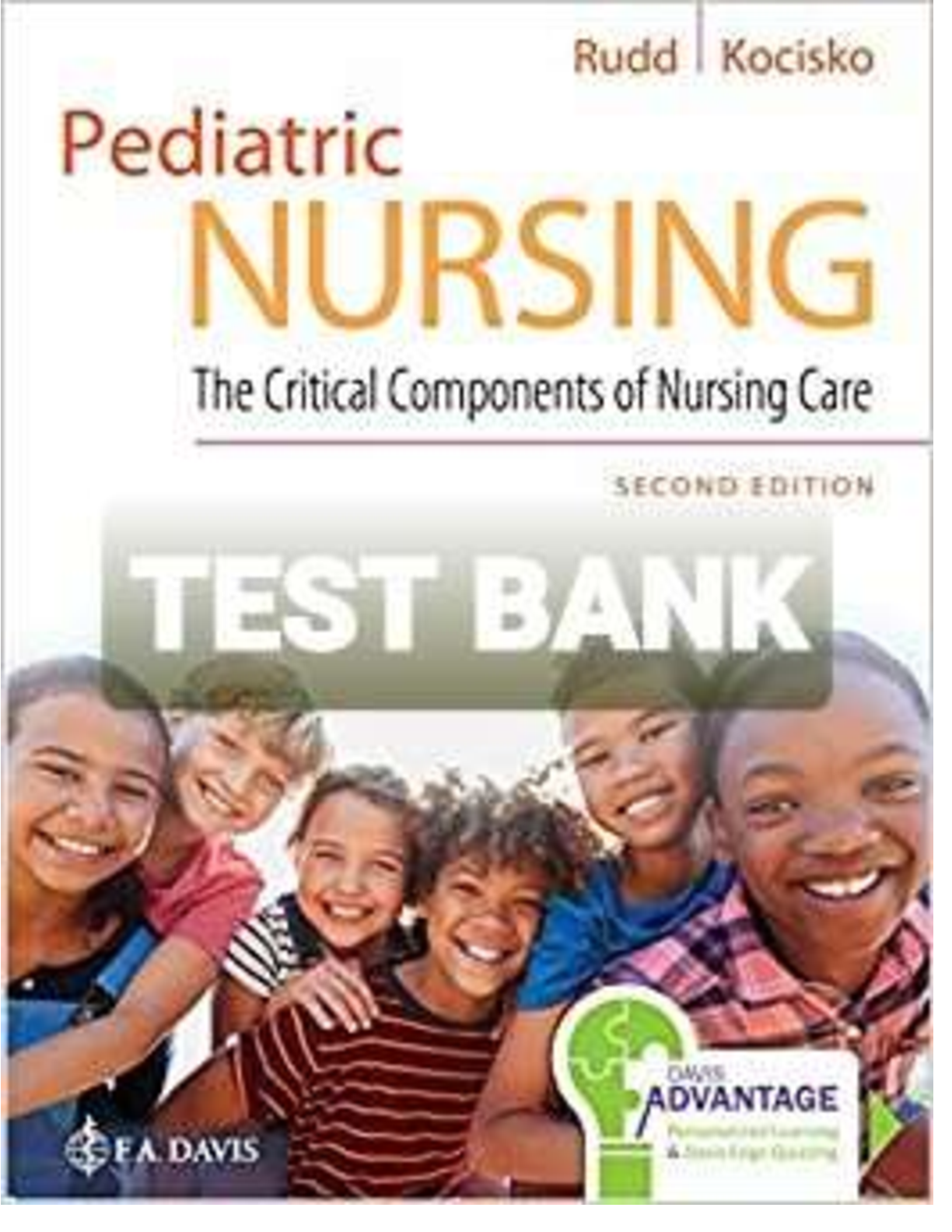
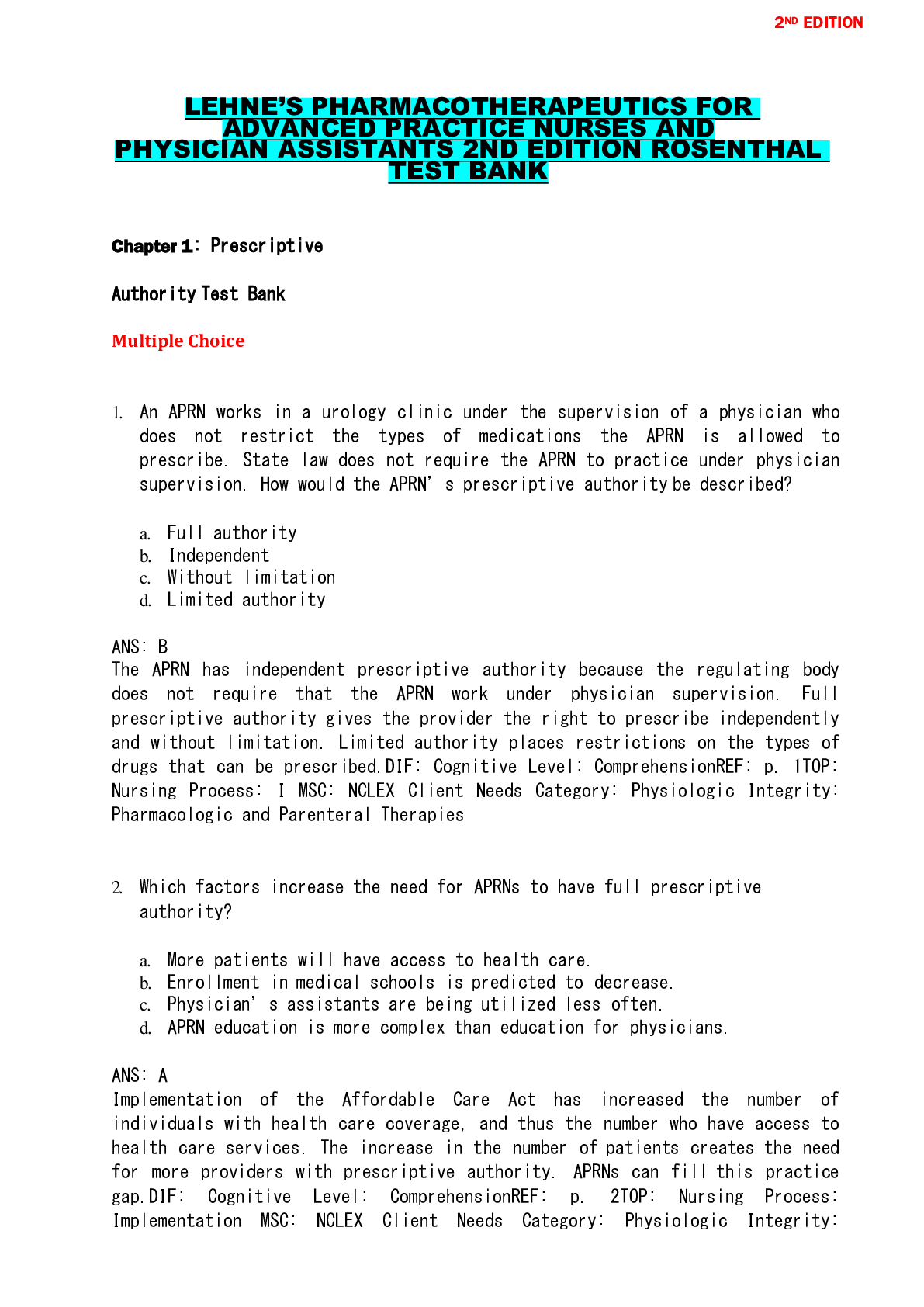
 1.png)

